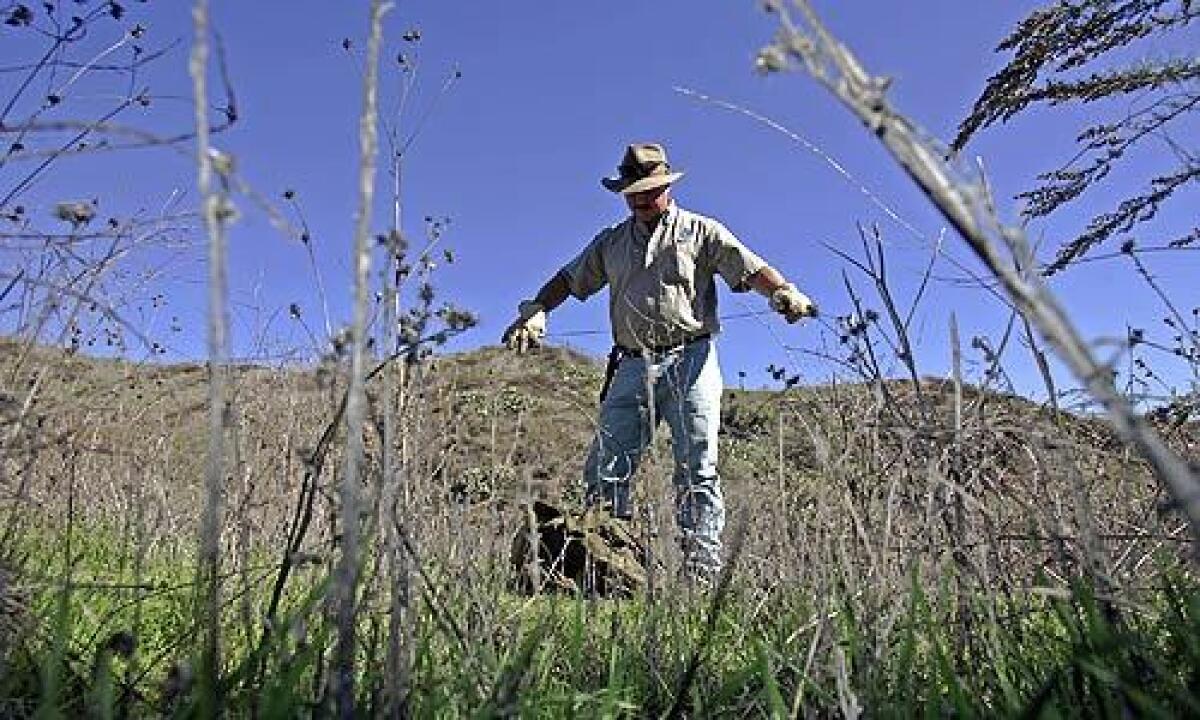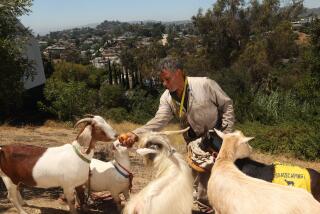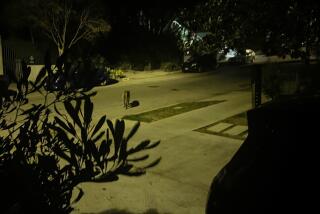Wily in the pursuit of coyotes

- Share via
Jimmie Rizzo puts a lump of chaw in his lip and picks his way into a ravine below a home in Redlands. Through a wrought-iron fence, a French bulldog named Phoebe yips, snorts and wheezes in her rhinestone collar. Rizzo tells her to shut up. He’s here to help.
For years, coyotes have fed on pets in this hilltop neighborhood. When residents complain to the county, the county calls Rizzo.
The trapper, born and raised in the hardwood forests of the Mississippi Delta, specializes in California’s big predators: coyotes, bears and mountain lions.
Bear and lion problems make news. Coyotes make business. Rizzo spends about 80% of his time tracking, trapping and putting down wild canids from Pacific Palisades to Twentynine Palms.
His services are at once widely sought and controversial, reflecting suburbia’s conflicted relationship with its wildlife.
This month, animal rights groups demanded the Huntington Library halt Rizzo’s trapping of coyotes in the botanical gardens, threatening in a letter to make a “broader public issue of the case.” At the same time, neighbors in San Marino have demanded the library do more to cull the coyotes living on the 207-acre property and feeding on their pets. One woman even sued the Huntington after her Pomeranian was killed a couple of blocks away.
Coyotes have adapted to civilization like no other predator, often breeding for generations completely detached from the wilderness.
Cities and suburbs offer much more sustenance than dry scrubland -- with little of the risk coyotesonce encountered when ranchers and hunters shot them as a matter of course. Coyotes sleep in hedges and drainages. They migrate along storm channels and miles of Southern California Edison easements. They drink from pools and pet bowls. They prey on cats and small dogs. They eat fallen fruit, dig scraps from compost heaps and raid bird feeders, trash cans and bags of pet food.
Rizzo, 45, has seen coyotes stalking along the 6-foot block walls between homes in Orange County, hunting for pets below. He’s come upon a sobbing man who had let his Doberman out to fight off a coyote who had jumped into the backyard -- only to see his pet killed within seconds.
A 25-pound coyote can kill a 70-pound dog and drag it over a 6-foot wall. Though coyotes do lose fights now and then, smaller, less ferocious dogs have no chance against them.
“Why are they going to go chase rabbits when you got Fifi locked up with a bowl of water to drink right next to her?” Rizzo asked.
A square mile of wilderness can support two to four coyotes, said Kevin Brennan, senior wildlife biologist for the California Department of Fish and Game. A square mile of suburbia might support a dozen coyotes or more, which has allowed them to expand well beyond their historical numbers.
“The situation is not natural,” Brennan said. “These are not coyotes who have wandered out of the hills and are trapped in the city trying to make it.”
Phoebe’s owner, Dianne Crowther, 63, said few of her neighbors in Redlands, southeast of San Bernardino, have cats anymore. “We had a cat, and he became coyote sushi.”
She said a pack of coyotes once even chased her when she went out to get the mail one night.
Crowther calls Rizzo a few times a year, when she says coyotes start lurking around her fence. She doesn’t care if animal rights activists call this type of regular trapping ineffective and cruel. She wants them gone.
“We don’t want to lose her,” she said of Phoebe. “She’s the light of our life.”
Rizzo, who is licensed by the state, said he has trapped and killed more than two dozen coyotes next to Crowther’s property in the last five years. This January morning, he studies the slopes for disturbed grass or subtle indentations in the clay soil, softened by recent rain. He finds two narrow animal trails threaded through the brush toward the house. He leans down to find a three-padded footprint.
He pulls a hammer from his bag and drives a steel anchor into the ground. Running from the anchor is 7 feet of cable with a loop at the end. Rizzo uses a stiff heavy-gauge wire to suspend the loop across the trail at the height of a coyote’s head. The underbrush makes the snare difficult to see.
If a coyote walks into it, the loop will pull tight like a choke chain.
The snare will not loosen until Rizzo arrives -- with a needle full of sodium pentothal and a Hefty lawn-and-garden bag for the ride to the hereafter.
Rizzo learned to hunt and trap as a boy on a small farm in Cleveland, Miss. His grandmother taught him to call muskrat, deer, coon, mink, fox and beaver. After he moved to Orange County in 1986, he started guiding hunts for bear, deer and turkey in the San Bernardino Mountains.
Six years ago, he became a full-time trapper for Animal Pest Management -- one of a handful of companies in Southern California licensed to eradicate problem cougars, black bears, foxes, bobcats and coyotes.
He keeps a team of hounds at the office and travels the Southland in a full-size Ford pickup loaded with tools, snares, guns and ammunition. With his wide-brimmed hat, faded Wranglers and Delta drawl, he looks about as out of place and anachronistic in, say, Coto de Caza or Bradbury as the coyotes and mountain lions he’s after. He’s a man who calls Copenhagen chewing tobacco “nectar of the gods” and packs his own rifle bullets in his backyard.
Rizzo’s company charges several thousand dollars for the average job, though the price can vary depending on the circumstances.
San Bernardino County contracts him to deal with the complaints it fields from residents about large predators. In other counties, homeowner and community associations hire him directly.
More and more, Rizzo is working in neighborhoods nowhere near the wild, like midcity Los Angeles, Garden Grove and Lakewood. “If you don’t have coyotes in your neighborhood now, you will,” he said.
Pete Immekus lobbied his City Council, in Walnut, to hire Rizzo for his coyote problems last month.
His family’s dachshunds had already survived two attacks when his mother spotted a coyote in the backyard. She managed to chase it away, but the coyote was intent on the dogs. In the next two days, the family had to run it off three more times.
The next afternoon, Immekus looked out an upstairs window to see the same coyote pop up on the wall. He ran downstairs to the patio door. The coyote loped across the yard and leaped over a wall into the neighbor’s property -- and, within seconds, was back on the wall. The dachshunds raced at it, barking as it paced along, almost playfully, drawing them to the back of the yard. Immekus dashed to get there, but the coyote pounced.
Both dogs sustained deep wounds in their necks and chests. By the time Immekus got there, one was in shock, with a torn ligament and a fractured shoulder. They would survive, but the vet bill would be more than $3,000.
The city agreed to hire Rizzo earlier this month. On Jan. 12, he quickly found where the coyotes were traveling down a drainage and set three traps in spots where their trails narrowed under bushes. On Jan. 20, he trapped and killed one. He wants to snare several more to drive home the message: They are not wanted here.
Mostly, coyotes live in suburbia without problems. But researchers say that as the animals have become more comfortable with humanity, they have become more aggressive.
A widely cited study by UC Davis in 2004 found that the first reported coyote attack in California not attributed to rabies occurred in 1978. In the next 25 years, there were 89 attacks on people or on pets in the presence of people. More than three-quarters of those came after 1994.
The biggest danger coyotes pose is to small children. The study’s authors, Robert Timm and Rex Baker, reported 35 incidents in which coyotes stalked or attacked young children -- including a 3-year-old girl killed in front of her home in Glendale in 1981.
“They do see children as prey,” Baker said. “There’s no two ways about it.”
He said the root of the problem is not with coyotes, but with humans. Too many people have a “Disney mentality” that prompts them to let the animals in their yards -- or even to leave food and water out for them.
“Our main thrust is to re-educate the public that wild animals are wild,” Baker said. “Once a coyote loses its fear of man, you have to re-instill it.”
Humans are not going to get rid of urban coyotes. Many appreciate the wildlife, and eradication efforts simply do not work.
“The coyote has been the most persecuted animal in North America,” said Brennan of Fish and Game. “Every predator control method known to man -- aerial gunning, poisoning, trapping, shooting -- they’ve survived them all.”
But he said that the targeted trapping practiced by Rizzo is effective -- and often residents’ only option once coyotes have become aggressive. The snaring re-instills the fear of humans, he added. Because coyotes are so communicative, word gets out.
Brennan said people often ask him why trapped coyotes cannot be relocated. “They want it to go to wild animal nirvana,” he said. “Unfortunately, nobody knows where that is. . . . You got two choices: Leave them alone or kill them.”
Animal rights groups vehemently disagree. Sean Guinan, urban wildlife coordinator for the Humane Society of the United States, said snaring has little effect and is cruel and indiscriminate. The snares don’t necessarily catch the problem coyote, might trap dogs and other animals and can cause an excruciating death by strangulation.
“It doesn’t resolve conflicts,” he said. “It’s a knee-jerk reaction to a non-problem.”
On Jan. 2, Guinan sent a letter to the Huntington Library demanding it stop its semiannual trapping or it would notify the media and the Humane Society’s 1.2 million members in California. He said the library can take other measures: removing food, clearing brush, educating the public about coyotes and hazing troublesome animals with loud noises, aggressive behavior, even paint guns.
The Huntington said it is taking other measures. It is are also sticking with Rizzo.
Rizzo comes back to Redlands the next day to check his traps. Nothing.
He grabs a game call from the truck, stands on the ridge and lets out the staccato yelp of a wounded cottontail rabbit. The sound pierces the cold, crystalline air and reverberates off the canyon walls. If coyotes are around, they’ll come running.
None do. Coyotes travel long distances and might vanish from a spot for a week at a time.
But they always come back.
A week after he set the traps, they do. He loads up his truck at his home in Lake Forest and rolls out. From the opposite side of the canyon, he can see his quarry. One dead coyote and one sitting -- panting and looking straight at Rizzo, very much aware of its predicament. It has dug deep holes trying to hide. It’s got no chance.
Rizzo descends upon it as quiet and resolute as the Angel of Death.
The animal hisses and rears up as he approaches. Phoebe barks and wheezes behind the fence. The trapped coyote whips around violently on the 7 feet of cable. It is small and wiry, 25 pounds of gristle, fur and teeth. Rizzo strides up with a dog-catcher’s pole and pins the writhing animal down. When Rizzo puts a blanket over its head, it stops moving. He takes a needle and injects it in a leg.
He walks over to the dead coyote, cuts it from the snare and hurls it into the canyon for the scavengers.
He returns to the other coyote, which is still breathing but no longer conscious. He cuts the snare off and admires the animal’s thick coat.
“All that expensive dog food has the same effect on coyotes as it does on dogs,” he says.
He puts the animal into the Hefty bag and heads off to the next call.
latimes.com /columnone Previous Column One articles are available online.
More to Read
Sign up for Essential California
The most important California stories and recommendations in your inbox every morning.
You may occasionally receive promotional content from the Los Angeles Times.











